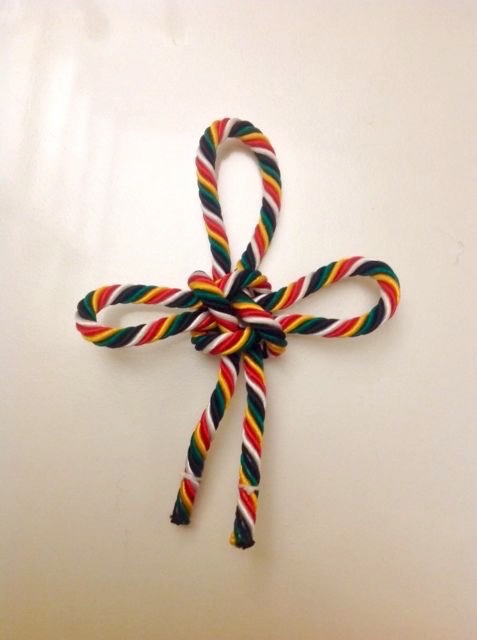The five-colored-rope bracelet which was given at Hasedera temple in Nara for the occasion of Eleven
The five-colored-rope bracelet which was given at Hasedera temple in Nara for the occasion of Eleven-face Kannon (a Bodhisattva) special viewing (usually hidden). I have not known what to do with the rugged, easily slackening rope loop, showing a tie to the humongous Kannon, but recently found that Hasedera introduces with footage untying and remaking to agemaki-musubi (a decorative rope work with supernatural intention) for a talisman. As I went into agemaki knotting, I knew it’s been used for quite a long time (since the tumultuous period—the mid-third century to the seventh century) and there two types exist: hito-gata (人型) to protect against evils and dangers, and iri-gata (入型) to invite good luck and happiness (the 人 and 入 kanji letters are according to how two sides crossing of the knot looks like. 型 means shape). Whereas hito-gata is often used for samurai’s helmets and armors (protection), iri-gata is used for bridal costume and furnishings (happiness). I also found Hasedera’s footage showed hito-gata (against evil), though shrines use iri-gata (good luck), so it turns out shrine and temple are using opposite-direction knotting—I don’t know what it means. I just simply followed Hasedera’s iri-gata knotting (protection) since the rope should be connected to Buddha, not god (kami). Then I removed silk scarf from my Coach bag and tied the rope to the handle. …Pretty stands out unexpectedly. I could even say traditional something of Spain or Italy (something’s what?). Anyway, the five-colored-rope bracelet is effectively utilized and now I’m protected. Great. How to knot agemaki-musubi (hito-gata/for protection)—Hasedera’s footage http://www.hasedera.or.jp/sp/promotion/1/blog_detail.html?key=entry&value=254 How to knot agemaki-musubi (iri-gata/for good luck) and actual use at shrine—by a Shinto priest with pictures http://blog.tennjinn.net/-how%20to-縄・紐の結び方/あげまき結びの結び方 Hasedera Temple (of Nara prefecture, Japan Visitor)http://www.japanvisitor.com/japan-temples-shrines/hasedera-nara 奈良の長谷寺の特別拝観でもらった五色線の腕輪。十一面観音様との結縁紐だが、ゴツくてすぐ緩むので持て余していたところ、長谷寺のHPで「ほどいてあげまき結びにしてお守りにすると宜しい」と動画で紹介しているのを知った。 調べてみるとあげまき結びは相当古くからある結び方(古墳時代以降)で、厄除の人型と招福の入型の2種類があることを知った(人・入は結目の2辺の交わりの形に由来)。人型は侍の鎧兜に使われるのに対し(厄除)、入型は花嫁衣裳や調度品に使われる(招福)。また、長谷寺の動画では人型(厄除)になっているのに対し、神社の説明では入型(招福)が使われていた。ということは、寺と神社で逆方向の結び方を採用していることになる。これってどういうことなんだろう? 謎だ。 仏さんとの結縁紐(けちえんひも)なので、自分は素直に長谷寺の厄除・入型結びに従ってみた。それでコーチのカバンに巻いていたシルクスカーフを外し、付けてみた。・・・思いのほか派手である。スペインかイタリアの伝統的な何かっぽく見えないこともない(何かって何よ?) ともあれ五色線の腕輪は有効活用され、私は加護を得た。素晴らしからんや。 あげまき結び(人型、厄除)ー長谷寺の動画http://www.hasedera.or.jp/sp/promotion/1/blog_detail.html?key=entry&value=254 あげまき結び(入型、招福)と実際の使用風景ー神主さんの説明図http://blog.tennjinn.net/-how%20to-縄・紐の結び方/あげまき結びの結び方 総角結び(あげまきむすび)の解説http://yuunet.jp/demo/pg137.html 長谷寺(奈良県)https://ja.m.wikipedia.org/wiki/長谷寺http://www.hasedera.or.jp/sp/ -- source link
Tumblr Blog : kyotokoyuki.tumblr.com
#japanese tradition#japanese culture#japantravel#knotting#rope work#talisman#amulet#spiritual#supernatural#jpanese temple#temple#shrine

